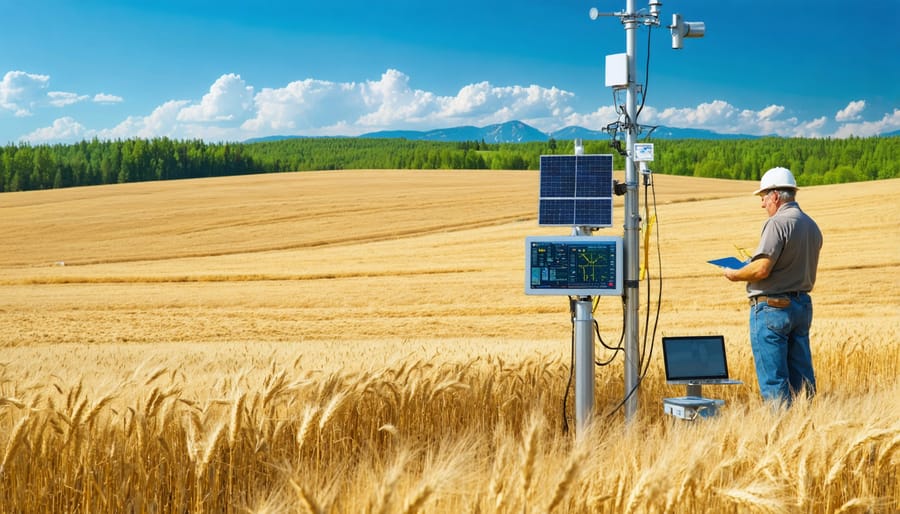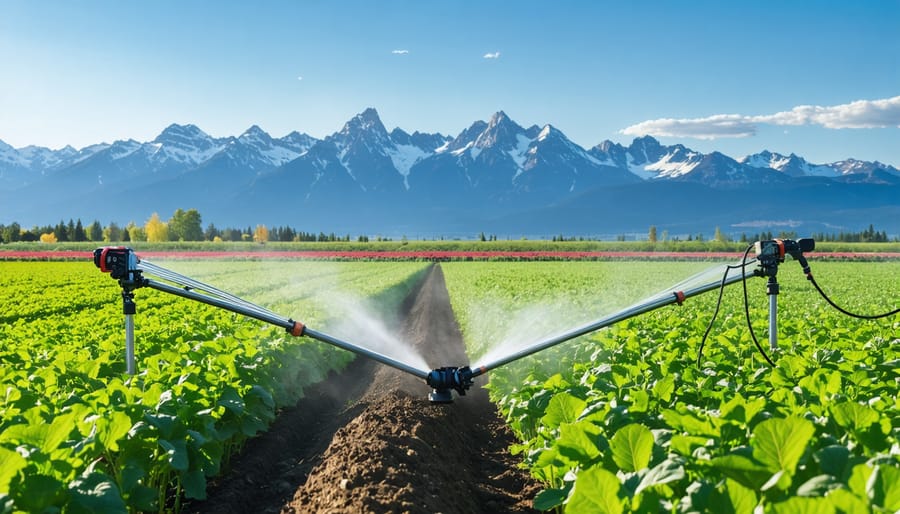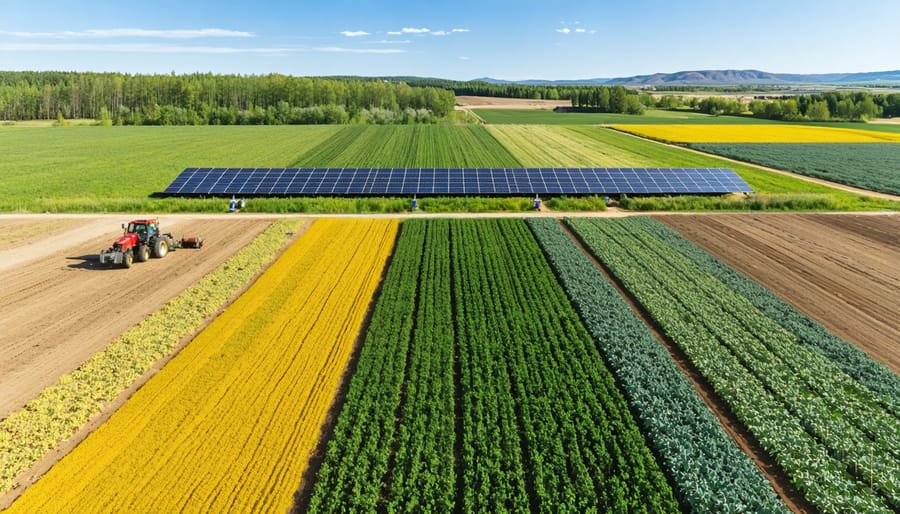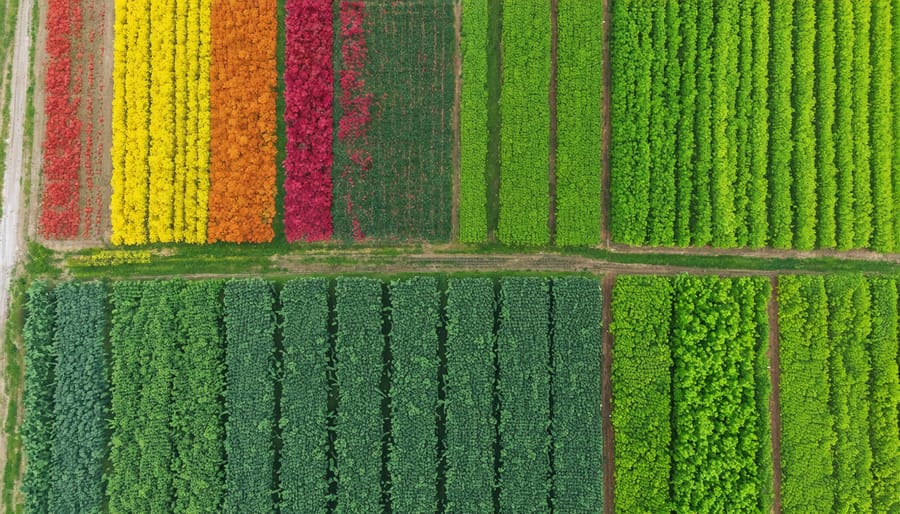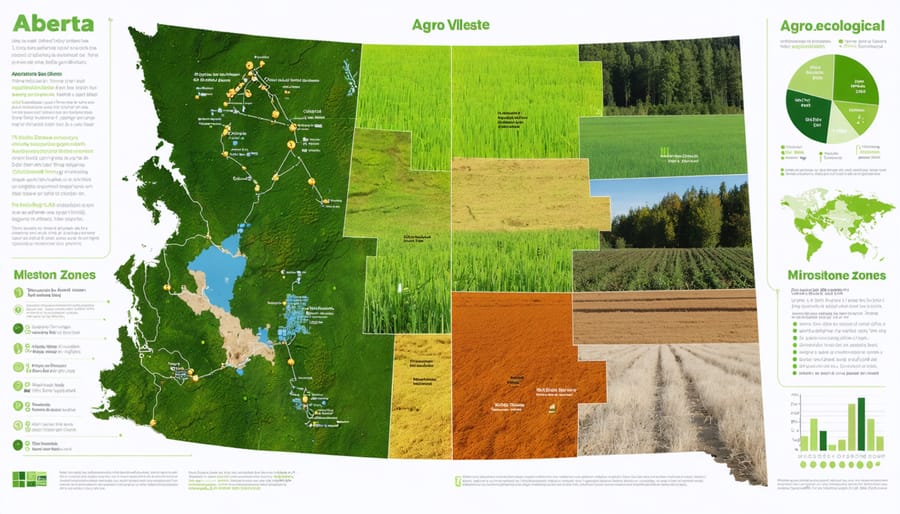Building resilient farms in Alberta demands immediate action as extreme weather patterns reshape our agricultural landscape. Forward-thinking organic farmers across the Prairie provinces are already implementing innovative climate adaptation strategies, proving that proactive measures can protect yields and soil health while maintaining organic certification.
From Medicine Hat to Grande Prairie, successful adaptation stories demonstrate how combining traditional knowledge with modern climate science creates sustainable solutions. Strategic crop selection, modified planting dates, and enhanced water management systems have helped organic operations maintain productivity despite increasing weather volatility. Research from the University of Alberta shows that farms implementing these adaptation strategies have experienced 30% better yield stability during extreme weather events compared to non-adapted operations.
The key to successful climate adaptation lies not in revolutionary changes but in strategic adjustments to existing organic practices. Through collaborative efforts between agricultural communities, research institutions, and government support programs, Alberta’s organic farmers are developing a blueprint for climate-resilient agriculture that maintains the integrity of organic principles while ensuring long-term farm viability.
These proven strategies, combined with available provincial resources and support networks, provide a clear path forward for organic producers seeking to strengthen their operations against climate challenges.
Alberta’s Changing Climate: What Organic Farmers Need to Know
Current Climate Trends in Alberta
Recent data from Environment Canada reveals significant shifts in Alberta’s agricultural regions, with farmers facing increasingly unpredictable current climate challenges. The past decade has shown a 1.4°C increase in average temperatures across the province’s farming belt, particularly affecting the growing season from April to October.
Southern Alberta has experienced more frequent drought conditions, with annual precipitation decreasing by 15% compared to historical averages. Meanwhile, central regions are seeing more intense rainfall events, often receiving 30-40mm of rain within 24 hours, which can damage crops and delay field operations.
The frost-free period has extended by approximately 2 weeks over the last 30 years, creating both opportunities and challenges for crop selection. However, this change has been accompanied by more extreme weather events, including devastating hailstorms that have increased in frequency by 20% since 2010.
Winter temperatures have become more variable, with sudden warm spells followed by sharp freezes, affecting winter wheat survival rates and soil moisture levels for spring seeding. These patterns underscore the need for adaptive farming strategies and resilient crop varieties.
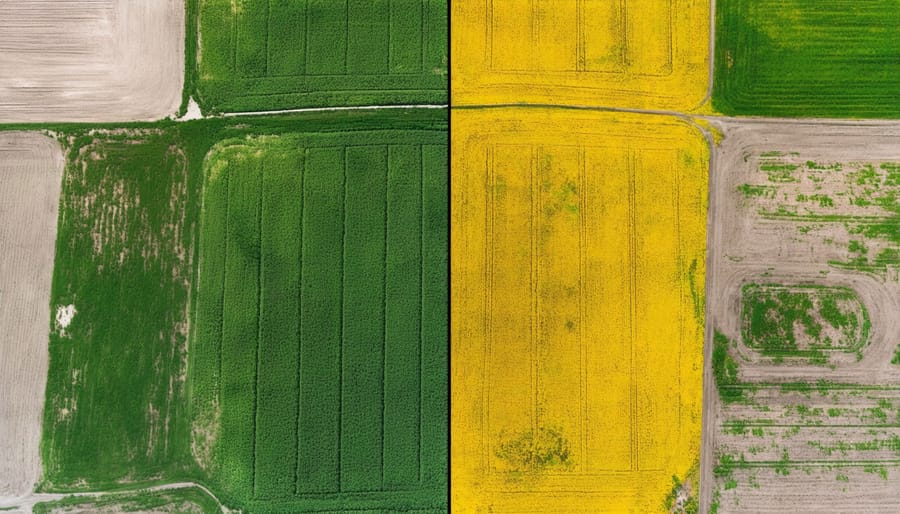
Impact on Organic Farming Operations
Climate change is reshaping organic farming operations across Alberta, with shifting weather patterns directly affecting crop performance and management practices. Many organic farmers report changes in growing seasons, with earlier spring thaws and later first frosts creating both opportunities and challenges for crop planning.
Local organic producers are experiencing increased variability in rainfall patterns, which particularly impacts dry-land farming operations. Some farmers have observed up to 30% fluctuation in crop yields between seasons, necessitating adaptive strategies to maintain consistent production.
These changes also affect organic certification requirements, as farmers must adjust their soil management and pest control methods while maintaining compliance with organic standards. For instance, more frequent extreme weather events have led many farmers to implement enhanced soil conservation practices, such as increased cover cropping and modified tillage schedules.
Growing season adjustments have prompted shifts in crop selection, with some producers successfully introducing new varieties better suited to changing conditions. Many Alberta organic farmers are now incorporating drought-resistant crops and experimenting with different planting dates to optimize yield potential under evolving climate patterns.
Success in adapting to these changes often depends on careful monitoring and documentation of weather patterns, crop responses, and soil health indicators. This data-driven approach helps farmers make informed decisions while maintaining organic integrity.
Soil Management Strategies That Work
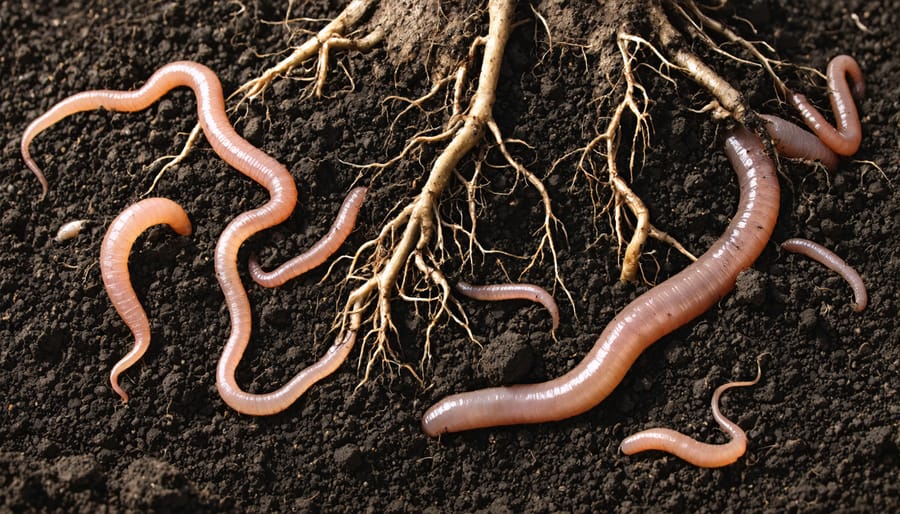
Building Climate-Resilient Soil
Building resilient soil is a cornerstone of successful climate adaptation in Alberta’s agricultural landscape. By implementing proven soil conservation techniques, farmers can significantly improve their land’s ability to withstand both drought and excessive moisture conditions.
The key to building climate-resilient soil lies in increasing organic matter content and enhancing soil structure. Adding compost and green manure crops can boost organic matter levels from typical 2-3% to optimal 5-7%, dramatically improving water retention capacity. For every 1% increase in organic matter, soil can hold an additional 25,000 litres of water per hectare.
Cover cropping with deep-rooted species like alfalfa and clover helps create stable soil aggregates and natural drainage channels. These improvements allow soil to better handle intense rainfall events while maintaining moisture during dry spells. Many Alberta farmers have found success using minimal tillage practices combined with diverse crop rotations.
Local farmer Sarah Thompson from Lacombe County reports: “Since implementing these soil-building practices five years ago, our fields have shown remarkable resilience. We’ve maintained steady yields despite weather extremes, and our soil structure improves each season.”
Consider incorporating beneficial microorganisms through biological amendments and maintaining year-round soil coverage to protect against erosion and temperature fluctuations. These practices create a more stable growing environment that can better withstand climate variability.
Cover Cropping Success Stories
Jim Anderson of Red Deer County has transformed his 800-hectare farm through innovative cover cropping practices. “After three years of implementing diverse cover crop mixes, we’ve seen a 30% increase in soil organic matter and significantly better water retention during dry spells,” Anderson shares. His rotation includes fall rye, hairy vetch, and crimson clover, carefully selected to thrive in Alberta’s climate.
In Leduc County, Sarah Martinez experimented with cocktail cover crops, combining eight different species including radishes, peas, and buckwheat. “The diversity has brought incredible resilience to our soil structure,” Martinez explains. “During the 2021 drought, our fields maintained moisture levels far better than neighboring conventional fields.”
The Thomson family farm near Lethbridge showcases how cover cropping can work in semi-arid conditions. Using drought-tolerant species like winter camelina and forage turnips, they’ve reduced wind erosion by 40% while providing additional grazing opportunities for their cattle herd.
Perhaps most impressive is the story of the Prairie Organic Cooperative, where twelve farmers collaborated to share equipment and knowledge about cover cropping. Their collective approach has led to a 25% reduction in input costs and improved soil health metrics across all participating farms.
These success stories demonstrate how Alberta farmers are adapting to climate challenges while building more resilient agricultural systems through strategic cover cropping choices.
Water Management Solutions
Irrigation Innovations
In response to increasingly unpredictable rainfall patterns, Alberta’s organic farmers are implementing innovative water management solutions that maximize efficiency while maintaining organic certification standards. Drip irrigation systems, particularly successful in Southern Alberta’s market gardens, deliver precise amounts of water directly to plant roots, reducing waste by up to 40% compared to traditional sprinkler systems.
Soil moisture sensors and weather-based irrigation scheduling are becoming standard practice, allowing farmers to make data-driven decisions about water application. These smart systems can be integrated with organic mulching techniques, such as straw or compost coverage, to further reduce evaporation and maintain soil moisture.
Many Alberta producers are also adopting sub-surface irrigation methods, which work exceptionally well with cover cropping strategies. This combination helps build soil organic matter while improving water retention capacity. Local farmer Sarah Thompson reports cutting water usage by 30% after implementing these techniques on her certified organic farm near Lethbridge.
For smaller operations, gravity-fed irrigation systems paired with rainwater harvesting have proven both cost-effective and environmentally sustainable. These systems typically pay for themselves within two growing seasons through reduced water costs and improved crop yields.
Drought-Proofing Methods
In Alberta’s evolving climate, implementing effective drought-proofing methods has become essential for farm resilience. Conservation tillage practices, which maintain crop residue on soil surfaces, can reduce moisture loss by up to 30%. Many local farmers have found success with cover cropping using drought-resistant species like fall rye and clover, which protect soil moisture while improving organic matter content.
Water-efficient irrigation systems, particularly drip irrigation, have shown promising results on Alberta farms, reducing water usage by 40-60% compared to traditional sprinkler systems. Soil moisture monitoring tools, such as tensionometers and digital probes, help farmers make informed decisions about irrigation timing and volume.
Creating windbreaks using native trees and shrubs has proven effective in reducing evaporation rates and protecting crops from drying winds. Several Alberta farmers have reported significant improvements in crop survival during dry spells after establishing strategic shelterbelts.
Drought-tolerant crop varieties adapted to local conditions offer another layer of protection. Many farmers are incorporating hardy heritage grains and pulses into their rotation systems. Maintaining healthy soil biology through organic practices enhances water retention capacity, with some farms reporting improved drought resistance after transitioning to organic methods.
Regular soil testing and amendments with locally-sourced organic matter help build drought resilience while maintaining compliance with organic certification requirements.
Crop Selection and Diversification
Climate-Hardy Crop Varieties
As Alberta’s climate continues to shift, farmers are increasingly turning to climate-resilient crop varieties that can withstand challenging weather conditions while maintaining strong yields. These adaptable crops have been developed through careful selection and breeding programs specifically for our prairie conditions.
Drought-tolerant wheat varieties like AAC Goodfire and AAC Crossfield have shown remarkable resilience during dry spells, while maintaining excellent grain quality. For pulse crops, newer varieties of yellow peas, such as CDC Inca and CDC Spectrum, demonstrate improved disease resistance and water-use efficiency.
Short-season corn hybrids are gaining popularity among Alberta farmers, offering earlier maturity dates that help avoid fall frost damage. Additionally, cold-tolerant faba beans and drought-resistant quinoa are emerging as viable alternatives for crop diversification.
Local seed producers are working closely with research institutions to develop varieties that specifically address our regional challenges. These include crops with deeper root systems for better moisture access, improved heat tolerance during flowering, and enhanced resistance to emerging pests and diseases.
When selecting climate-hardy varieties, consider your specific soil conditions, typical moisture patterns, and frost-free days in your area. Your local seed supplier or agricultural extension office can provide guidance on the best options for your farm.
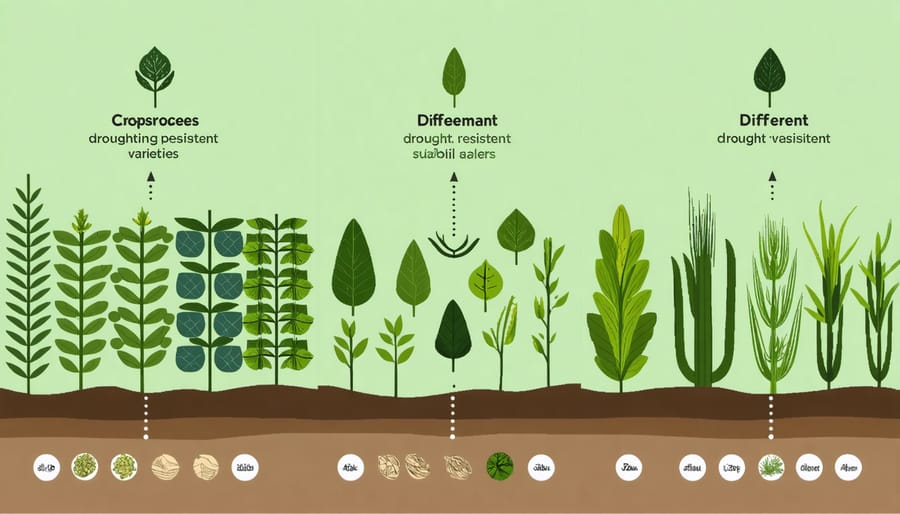
Successful Crop Rotation Models
In Alberta’s changing climate, strategic crop rotation has become essential for farm resilience. Several successful models have emerged from local farming communities, proving particularly effective in managing soil health and adapting to weather uncertainties.
The “Three-Year Prairie Rotation” has shown remarkable results, alternating between cereals, pulse crops, and oilseeds. This pattern helps break pest cycles while improving soil structure and nutrient availability. For example, rotating canola with wheat and field peas has helped farmers in Red Deer County increase yields by 15% while reducing fertilizer needs.
Another proven approach is the “Four-Field System,” which incorporates cover crops as a fourth rotation element. Central Alberta farmers have successfully used combinations like barley, followed by peas, then canola, and finally a cover crop mix of clover and rye. This system has demonstrated improved water retention and reduced soil erosion during extreme weather events.
For smaller operations, the “Market Garden Rotation” has proven effective, rotating between root crops, leafy greens, and soil-building legumes. This model, popular among organic farmers near Edmonton, has shown remarkable resilience during both drought and excessive rainfall periods while maintaining consistent production levels.
These rotation patterns work best when tailored to local soil conditions and market demands, with flexibility built in for climate variability.
Financial Resources and Support
Various financial resources and support programs are available to help Alberta farmers implement climate adaptation strategies. The Canadian Agricultural Partnership (CAP) offers cost-sharing programs specifically designed for climate resilience projects, with funding covering up to 50% of eligible expenses for qualified applicants.
The Environmental Farm Plan (EFP) program provides both technical assistance and financial incentives for farmers implementing sustainable practices. After completing an EFP assessment, farmers can access grants for projects like water management systems, soil conservation measures, and energy-efficient equipment upgrades.
Local agricultural societies and producer groups often provide matching funds or micro-grants for innovative adaptation projects. The Alberta Federation of Agriculture maintains a database of current funding opportunities and can assist with application processes.
For organic farmers, additional support is available through certification cost-share programs and transition assistance funds. The Organic Federation of Canada offers specific grants for climate adaptation projects that align with organic certification requirements.
Government-backed loan programs through Farm Credit Canada and ATB Financial offer preferential rates for climate adaptation investments. These loans can help finance larger projects like irrigation systems or protected growing structures.
Technical support is equally important as financial assistance. The Alberta Climate Information Service (ACIS) provides free climate monitoring tools and forecasting services. Agricultural fieldmen and regional extension specialists offer complimentary consultations to help farmers develop adaptation strategies and identify suitable funding programs.
Remember to connect with your local agricultural service board for guidance on available programs and application deadlines. Many programs operate on a first-come, first-served basis, so early applications are recommended.
As Alberta’s farming community continues to face climate challenges, implementing adaptation strategies is not just an option – it’s essential for long-term success. The strategies we’ve explored offer practical solutions that can help protect your farm’s productivity while contributing to environmental sustainability. From water conservation techniques to crop diversification, each approach can be tailored to your specific operation’s needs.
Remember that successful adaptation is an ongoing process. Start with small, manageable changes and gradually expand your efforts as you gain confidence and experience. Take advantage of local agricultural extension services, connect with fellow farmers who have implemented similar strategies, and stay informed about new research and technologies emerging in our region.
The support network for Alberta farmers is strong and growing. Provincial programs, agricultural cooperatives, and research institutions are all valuable resources as you implement these changes. By working together and sharing our experiences, we can build more resilient farming operations that will continue to thrive for generations to come.
Your next steps might include conducting a climate vulnerability assessment of your farm, reaching out to local agricultural advisors, or joining a farmer-led climate adaptation group in your area. Every step forward, no matter how small, contributes to the broader goal of creating a more sustainable and resilient agricultural future for Alberta.


